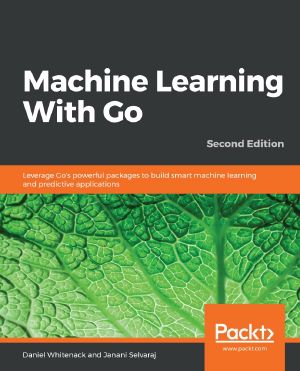Machine Learning With Go, Second Edition

- Authors
- Whitenack, Daniel
- Publisher
- Packt Publishing
- Tags
- com042000 - computers , natural language processing , com044000 - computers , neural networks , com004000 - computers , intelligence (ai) and semantics
- Date
- 2019-04-30T00:00:00+00:00
- Size
- 7.59 MB
- Lang
- en
Infuse an extra layer of intelligence into your Go applications with machine learning and AI
Key Features Build simple, maintainable, and easy to deploy machine learning applications with popular Go packages Learn the statistics, algorithms, and techniques to implement machine learning Overcome the common challenges faced while deploying and scaling the machine learning workflows Book Description
This updated edition of the popular Machine Learning With Go shows you how to overcome the common challenges of integrating analysis and machine learning code within an existing engineering organization.
Machine Learning With Go, Second Edition, will begin by helping you gain an understanding of how to gather, organize, and parse real-world data from a variety of sources. The book also provides absolute coverage in developing groundbreaking machine learning pipelines including predictive models, data visualizations, and statistical techniques. Up next, you will learn the thorough utilization of Golang libraries including golearn, gorgonia, gosl, hector, and mat64. You will discover the various TensorFlow capabilities, along with building simple neural networks and integrating them into machine learning models. You will also gain hands-on experience implementing essential machine learning techniques such as regression, classification, and clustering with the relevant Go packages. Furthermore, you will deep dive into the various Go tools that help you build deep neural networks. Lastly, you will become well versed with best practices for machine learning model tuning and optimization.
By the end of the book, you will have a solid machine learning mindset and a powerful Go toolkit of techniques, packages, and example implementations
What you will learn Become well versed with data processing, parsing, and cleaning using Go packages Learn to gather data from various sources and in various real-world formats Perform regression, classification, and image processing with neural networks Evaluate and detect anomalies in a time series model Understand common deep learning architectures to learn how each model is built Learn how to optimize, build, and scale machine learning workflows Discover the best practices for machine learning model tuning for successful deployments Who this book is for
This book is primarily for Go programmers who want to become a machine learning engineer and to build a solid machine learning mindset along with a good hold on Go packages. This is also useful for data analysts, data engineers, machine learning users who want to run their machine learning experiments using the Go ecosystem. Prior understanding of linear algebra is required to benefit from this book
Table of Contents Gathering and Organizing Data Matrices, Probability, and Statistics Evaluating and Validating Regression Classification Clustering Time Series and Anomaly Detection Neural Networks Deep Learning Deploying and Distributing Analyses and Models Appendix: Algorithms/Techniques Related to Machine Learning